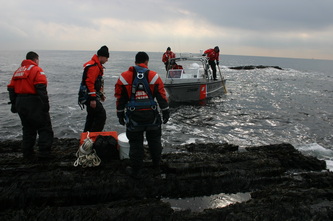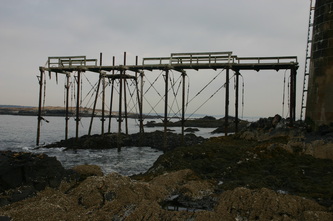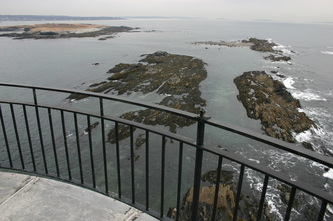History of Ram Island Ledge Light, Casco Bay, Maine
© Jeremy D'Entremont. Do not reproduce any images or text from this website without permission of the author.
The white double flash which shows every six seconds has already eased the minds of hundreds of mariners who have strained their eyes to catch its first warning of the presence of the black rock upon which the lighthouse rears high its gray conical tower. In thick weather, once in every ten seconds, the penetrating clang of the sonorous bell indicates the rock's whereabouts to the nearby mariners. -- Alfred O. Elden, "Beacons that Shine in Casco Bay," Pine Tree Magazine, August 1906.

U.S. Coast Guard photo
Ram Island, about a mile offshore from Portland Head near the entrance to Portland Harbor, is surrounded by dangerous ledges. As far back as 1855, an iron spindle was erected as a navigational aid on Ram Island Ledge, which extends for a quarter mile from Ram Island. A larger 50-foot wooden tripod was placed there in 1873. These markers were helpful in clear weather, but in bad weather they were virtually invisible.
Shipwrecks continued with frequency. On May 27, 1866, alone, there were four wrecks. Many fishing boats and schooners struck the ledges over the years, often while trying to make Portland Harbor in bad weather. On February 24, 1900, the 400-foot transatlantic steamer California went aground at Ram Island Ledge in a snowstorm. There was no loss of life, and the steamer was refloated six weeks later. This near-tragedy finally convinced the federal government that a lighthouse was called for.
In 1902, Congress appropriated funds for the building of a lighthouse on Ram Island Ledge. In 1903, the federal government purchased the ledges from two Cape Elizabeth families for $500.
Shipwrecks continued with frequency. On May 27, 1866, alone, there were four wrecks. Many fishing boats and schooners struck the ledges over the years, often while trying to make Portland Harbor in bad weather. On February 24, 1900, the 400-foot transatlantic steamer California went aground at Ram Island Ledge in a snowstorm. There was no loss of life, and the steamer was refloated six weeks later. This near-tragedy finally convinced the federal government that a lighthouse was called for.
In 1902, Congress appropriated funds for the building of a lighthouse on Ram Island Ledge. In 1903, the federal government purchased the ledges from two Cape Elizabeth families for $500.
The granite tower is nearly a twin of Graves Light in outer Boston Harbor, which was built almost at the same time.

Ram Island Ledge was submerged much of the time, meaning that construction could only take place at low tide. Work began on May 1, 1903. Temporary quarters were set up for the workers on Ram Island.
A Rockland company provided granite blocks from Vinalhaven. The giant blocks were brought to Central Wharf in Portland, numbered to indicate their position, and then ferried to the ledge, which had been leveled to three feet above mean low water. The first stones were laid on Ram Island Ledge in July 1903.
By the end of September, the tower reached a height of 32 feet. A crew of 25 men worked from April to July 1904 to complete the tower.
A 26,000-pound lantern was placed on the tower and fitted with a third-order Fresnel lens. With the lantern, the lighthouse reached a height of 90 feet, with the light 77 feet above mean high water.
An iron pier was added to the ledge, and the kerosene lamp was first lighted on January 23, 1905.
Below: Scenes from the construction of Ram Island Ledge Light. Courtesy of Jim Claflin.
A Rockland company provided granite blocks from Vinalhaven. The giant blocks were brought to Central Wharf in Portland, numbered to indicate their position, and then ferried to the ledge, which had been leveled to three feet above mean low water. The first stones were laid on Ram Island Ledge in July 1903.
By the end of September, the tower reached a height of 32 feet. A crew of 25 men worked from April to July 1904 to complete the tower.
A 26,000-pound lantern was placed on the tower and fitted with a third-order Fresnel lens. With the lantern, the lighthouse reached a height of 90 feet, with the light 77 feet above mean high water.
An iron pier was added to the ledge, and the kerosene lamp was first lighted on January 23, 1905.
Below: Scenes from the construction of Ram Island Ledge Light. Courtesy of Jim Claflin.
The light's flashing characteristic was produced by a clockwork mechanism that rotated the lens, which floated on a bed of mercury. The mechanism had to be wound every hour and a half by the keepers. A fog bell went into operation on August 28, 1905.

The first head keeper was William C. Tapley, who served until 1929. There were three keepers assigned to the station. Each keeper stayed for two weeks, with daily 12-hour shifts, followed by a week of shore leave. The keepers lived inside the tower. Like Minot's Ledge Light and Graves Light, the lower part of the tower held a water cistern.
Joe Johansen was an assistant keeper at Ram Island Ledge from 1949 to 1950. He told an interviewer for the Island Institute about his life there:
You could have been living in the 1800s because, other than the link with the radio, there were no conveniences at all. Nothing.
It was lonesome in a way, but you were never really lonely, because there were always two of you aboard. In the winters the nights were kind of long because you split the watch... You usually stood watch in the galley because that's where your only source of heat was: a kerosene stove, which we used for cooking and heat.
Johansen once spent 45 days straight at the light during rough winter weather. As their food supply ran low, he and another keeper were reduced to eating oatmeal three times a day.
Click here to hear an interview with Joe Johansen from WMPG.
Joe Johansen was an assistant keeper at Ram Island Ledge from 1949 to 1950. He told an interviewer for the Island Institute about his life there:
You could have been living in the 1800s because, other than the link with the radio, there were no conveniences at all. Nothing.
It was lonesome in a way, but you were never really lonely, because there were always two of you aboard. In the winters the nights were kind of long because you split the watch... You usually stood watch in the galley because that's where your only source of heat was: a kerosene stove, which we used for cooking and heat.
Johansen once spent 45 days straight at the light during rough winter weather. As their food supply ran low, he and another keeper were reduced to eating oatmeal three times a day.
Click here to hear an interview with Joe Johansen from WMPG.
The light was electrified in 1958 via an underwater cable extending from Portland Head. The automated light and fog signal were monitored remotely by the keepers at Portland Head Light Station, enabling the Coast Guard to remove the keepers from Ram Island Ledge in 1959.
Under the Maine Lights Program coordinated by the Island Institute in Rockland in 1997-98, Ram Island Ledge Light was expected to become the property of some local organization, but none applied due to the lighthouse's relative inaccessability.
Below: A gallery of photos from a visit to the lighthouse with the Coast Guard Aids to Navigation Team South Portland in February 2006.
Under the Maine Lights Program coordinated by the Island Institute in Rockland in 1997-98, Ram Island Ledge Light was expected to become the property of some local organization, but none applied due to the lighthouse's relative inaccessability.
Below: A gallery of photos from a visit to the lighthouse with the Coast Guard Aids to Navigation Team South Portland in February 2006.
The light was converted to solar power in January 2001. The solar panels mounted on the south side of the tower provide power for two large batteries supplying the light and fog signal.

U.S. Coast Guard
In 2009, the lighthouse again became available to a new steward under the provisions of the National Historic Lighthouse Preservation Act of 2000. There were no applicants, and the lighthouse was put up for auction to the general public in the summer of 2010. On September 14, 2010, it was sold to Dr. Jeffrey Florman of Windham, Maine, for $190,000.
Ram Island Ledge Light can be clearly seen from Portland Head Light and from some of the tour boats leaving Portland.
Keepers: The following list of keepers is not complete. It is a work in progress, and any additional information is welcomed and appreciated; you can email me at [email protected]. If you copy this list to another site, you do so at your own risk. I can't guarantee its accuracy.
William C. Tapley (1905-1929); Arnold B. White (first assistant, 1909); ? Merritt (assistant, 1905-?); ? Latham (assistant, 1905-?); Walter L. Emerson (second assistant, 1914-?); Robert Thayer Sterling (assistant, c. 1915); Leroy L. Myers (c. 1935); R.J. Carr, assistant (c. 1935); L. McBride, assistant (c. 1935); Joe Johansen (Coast Guard assistant, 1949-1950); Irving T. Sparrow (c. 1950)
Ram Island Ledge Light can be clearly seen from Portland Head Light and from some of the tour boats leaving Portland.
Keepers: The following list of keepers is not complete. It is a work in progress, and any additional information is welcomed and appreciated; you can email me at [email protected]. If you copy this list to another site, you do so at your own risk. I can't guarantee its accuracy.
William C. Tapley (1905-1929); Arnold B. White (first assistant, 1909); ? Merritt (assistant, 1905-?); ? Latham (assistant, 1905-?); Walter L. Emerson (second assistant, 1914-?); Robert Thayer Sterling (assistant, c. 1915); Leroy L. Myers (c. 1935); R.J. Carr, assistant (c. 1935); L. McBride, assistant (c. 1935); Joe Johansen (Coast Guard assistant, 1949-1950); Irving T. Sparrow (c. 1950)











